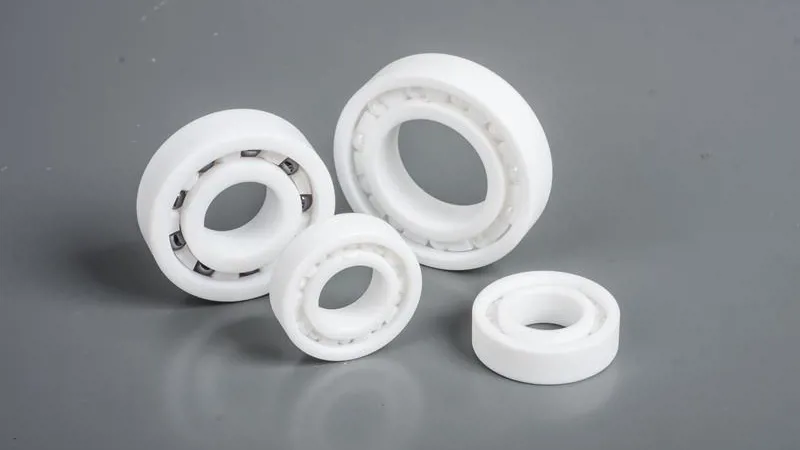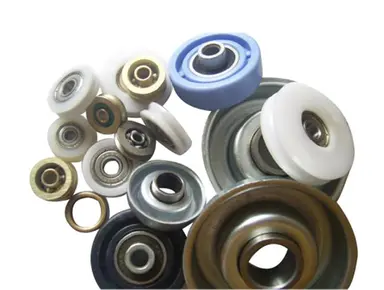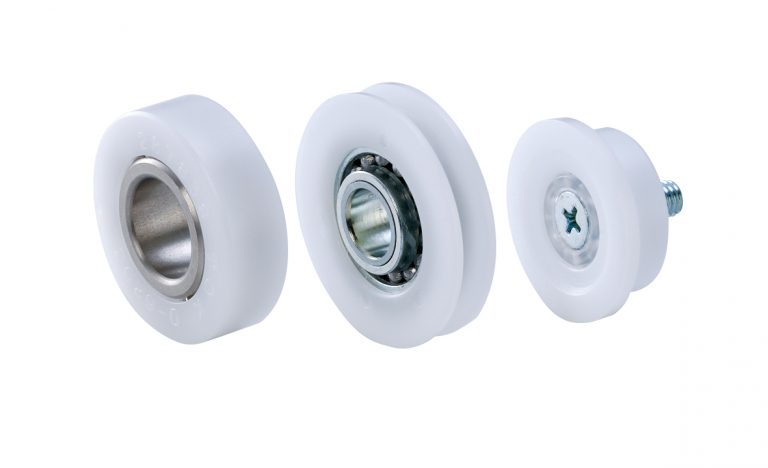
Can you describe the various types of seals and shields used with plastic bearings for contamination prevention?
Yes, I can describe the various types of seals and shields used with plastic bearings for contamination prevention. Here’s a detailed explanation:
- 1. Contact Seals:
Contact seals, also known as lip seals or rubber seals, are common types of seals used with plastic bearings. These seals are made of elastomers such as nitrile rubber (NBR) or fluorocarbon rubber (FKM) and provide a physical barrier between the bearing and the external environment. Contact seals have a lip that makes direct contact with the inner or outer ring of the bearing, effectively preventing the entry of contaminants such as dust, dirt, or moisture. They offer good sealing performance and are suitable for applications with moderate operating speeds and temperatures.
- 2. Non-Contact Seals:
Non-contact seals, also known as labyrinth seals or gap seals, are designed to minimize friction and allow for higher operating speeds. These seals consist of multiple labyrinth-like grooves or channels that create a tortuous path for contaminants, preventing their entry into the bearing. Non-contact seals are typically made of materials like plastic or metal. They offer reduced heat generation, lower torque, and increased efficiency compared to contact seals. However, they may not provide as high a level of contamination protection in extremely dusty or wet environments.
- 3. Shields:
Shields, also referred to as metal shields or metal covers, are used with plastic bearings to provide a barrier against contaminants. Shields are generally made of metal, such as stainless steel or sheet steel, and are attached to the outer ring of the bearing. They have a gap or clearance between the shield and the inner ring, allowing for smooth rotation while preventing larger particles or debris from entering the bearing. Shields offer good protection against coarse contaminants and are suitable for applications with moderate speeds and temperatures.
- 4. Combination Seals and Shields:
In certain applications, a combination of seals and shields may be used to provide enhanced contamination prevention. These combination seals and shields offer a dual-layered protection system. For example, a plastic bearing may have a contact seal on one side to provide effective sealing against contaminants, while a shield is used on the other side to provide additional protection and allow for visual inspection or lubrication access. This combination approach offers flexibility and adaptability to different operating conditions and contamination risks.
- 5. Customized Sealing Solutions:
In addition to standard seals and shields, customized sealing solutions can be developed based on specific application requirements. Custom seals or shields can be designed to address unique challenges such as extreme temperatures, aggressive chemicals, or high-pressure environments. These specialized sealing solutions ensure optimal contamination prevention and performance in demanding applications.
In summary, plastic bearings can be equipped with various types of seals and shields for contamination prevention. Contact seals, non-contact seals, shields, and combination seals and shields are commonly used to provide a barrier against contaminants such as dust, dirt, or moisture. The selection of the appropriate sealing solution depends on factors such as operating conditions, contamination risks, speed requirements, and specific application needs. By effectively preventing contamination, these seals and shields contribute to the reliable and long-lasting performance of plastic bearings in diverse industrial and mechanical applications.

Can you explain the installation and alignment considerations for plastic bearings?
Proper installation and alignment are crucial for the optimal performance and longevity of plastic bearings. Here’s a detailed explanation of the installation and alignment considerations:
- 1. Clean and Dry Surfaces:
Before installing plastic bearings, it is important to ensure that the mating surfaces are clean and dry. Any dirt, debris, or moisture on the surfaces can affect the fit and performance of the bearings. Clean the surfaces thoroughly and remove any contaminants before proceeding with the installation.
- 2. Bearing Housing Preparation:
The bearing housing should be prepared to provide a proper fit for the plastic bearings. This may involve cleaning the housing, removing burrs or sharp edges, and ensuring that the housing is dimensionally accurate. The bearing housing should be free from any defects that could hinder the installation or affect the alignment of the bearings.
- 3. Proper Shaft and Bearing Fit:
It is essential to ensure the proper fit between the shaft and the plastic bearings. The shaft diameter should match the recommended tolerance range provided by the bearing manufacturer. If the fit is too loose, the bearings may slip or have excessive play, while a fit that is too tight can cause increased friction and premature wear. Follow the manufacturer’s guidelines for the recommended fit and tolerances.
- 4. Alignment:
Proper alignment is critical for the smooth operation of plastic bearings. Misalignment can lead to increased friction, premature wear, and reduced bearing lifespan. Ensure that the shaft and bearing housing are aligned concentrically and parallel to each other. Misalignment can be checked using alignment tools, such as dial indicators or laser alignment systems, and adjustments should be made accordingly to achieve the correct alignment.
- 5. Mounting and Fixing:
Plastic bearings should be securely mounted and fixed in the bearing housing. Follow the manufacturer’s instructions for the appropriate mounting method, which may involve press-fitting, snap-fitting, or other techniques. Use the recommended tools or equipment to ensure a proper and secure fit. Pay attention to any locking mechanisms or retaining devices that may be required to prevent the bearings from rotating or moving within the housing.
- 6. Lubrication:
Depending on the type of plastic bearings, lubrication requirements may vary. Some plastic bearings are self-lubricating and do not require additional lubrication, while others may benefit from a thin film of lubricant. Follow the manufacturer’s guidelines for the appropriate lubrication method and interval, if applicable, to ensure optimal performance and longevity of the bearings.
In summary, proper installation and alignment are essential for the effective functioning of plastic bearings. Considerations such as clean and dry surfaces, bearing housing preparation, proper shaft and bearing fit, alignment, secure mounting and fixing, and appropriate lubrication contribute to the successful installation and alignment of plastic bearings.

Can you explain the advantages and characteristics of plastic bearings in various applications?
Plastic bearings offer several advantages and characteristics that make them suitable for various applications. Here’s a detailed explanation of the advantages and characteristics of plastic bearings:
- Advantages of Plastic Bearings:
Plastic bearings provide several advantages over traditional metal bearings, depending on the specific application requirements. Here are some key advantages:
- 1. Corrosion Resistance: Plastic bearings are highly resistant to corrosion, making them suitable for applications in environments where moisture, chemicals, or corrosive substances are present. Unlike metal bearings that may corrode over time, plastic bearings maintain their integrity and performance even in harsh conditions.
- 2. Self-Lubrication: Many plastic bearings are designed with self-lubricating properties. They incorporate solid lubricants or additives within the plastic material, reducing the need for external lubrication. Self-lubricating plastic bearings offer lower friction, improved wear resistance, and reduced maintenance requirements.
- 3. Lightweight: Plastic bearings are generally lighter in weight compared to metal bearings. This characteristic is advantageous in applications where weight reduction is desired, such as in automotive, aerospace, or portable equipment. The lighter weight of plastic bearings can contribute to energy savings, improved efficiency, and easier handling.
- 4. Low Friction: Plastic bearings typically have low friction coefficients, which result in smoother operation and reduced energy consumption. The low friction properties of plastic bearings minimize wear and heat generation, leading to extended bearing life and improved overall system performance.
- 5. Noise Reduction: Plastic bearings possess inherent damping properties that help reduce noise levels in machinery and equipment. The ability of plastic materials to absorb vibrations and dampen noise can enhance user comfort, reduce noise pollution, and improve the working environment.
- 6. Electrical Insulation: Some plastic bearings offer electrical insulation properties, making them suitable for applications where electrical conductivity needs to be avoided. Plastic bearings can help prevent electrical current flow, reduce the risk of electrical arcing, and enhance safety in certain equipment or systems.
- 7. Chemical Resistance: Plastic bearings exhibit excellent resistance to various chemicals, solvents, and aggressive substances. This characteristic makes them suitable for applications in chemical processing, pharmaceutical, and laboratory equipment where exposure to chemicals is common.
- Characteristics of Plastic Bearings:
In addition to their advantages, plastic bearings have certain characteristics that make them well-suited for specific applications. Here are some notable characteristics:
- 1. Material Selection: Plastic bearings are available in a wide range of materials, such as polytetrafluoroethylene (PTFE), polyoxymethylene (POM), polyamide (PA), or polyetheretherketone (PEEK). Each material offers unique properties, such as temperature resistance, chemical compatibility, wear resistance, or load-carrying capacity. The ability to select the most appropriate material for a specific application allows for customization and optimization of bearing performance.
- 2. Design Flexibility: Plastic bearings can be manufactured using various molding or machining processes, providing design flexibility. The ability to create complex geometries, incorporate features like seals or flanges, or customize dimensions makes plastic bearings adaptable to diverse application requirements.
- 3. Low Maintenance: Plastic bearings often require minimal maintenance due to their self-lubricating properties and resistance to corrosion and wear. This characteristic reduces the need for frequent re-lubrication or replacement, resulting in cost savings and increased equipment uptime.
- 4. Temperature Range: While plastic bearings have temperature limitations compared to some metal bearings, certain plastic materials can withstand a wide temperature range. For example, PEEK bearings offer high-temperature resistance, making them suitable for applications that operate in elevated temperatures.
- 5. Load Capacity: Plastic bearings generally have lower load-carrying capacities compared to metal bearings. However, advancements in plastic bearing design and material technology have allowed for the development of high-performance plastic bearings capable of handling moderate to heavy loads in specific applications.
- 6. Cost-Effectiveness: Plastic bearings can offer cost advantages over metal bearings in certain scenarios. The lower material and production costs associated with plastic bearings, combined with their extended service life and reduced maintenance requirements, can result in overall cost savings throughout the lifespan of the equipment.
By leveraging the advantages and characteristics ofplastic bearings, engineers and designers can optimize the performance, reliability, and efficiency of machinery and equipment in a wide range of applications. The specific advantages and characteristics of plastic bearings should be carefully considered and evaluated based on the requirements of each application to ensure the optimal selection and utilization of these bearings.


editor by CX 2024-05-09